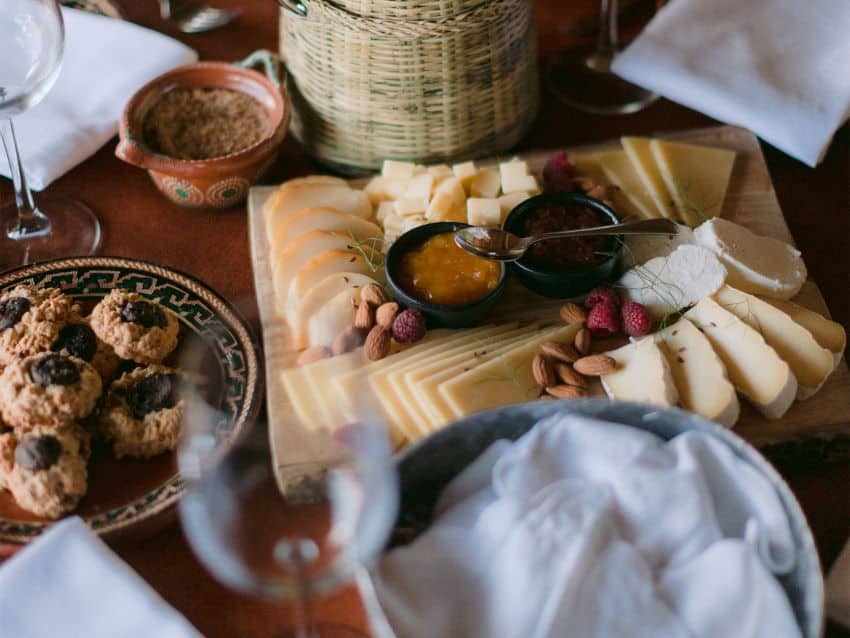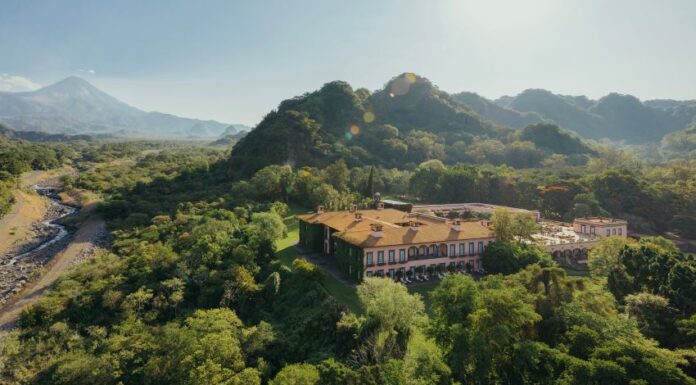As expats living in Dubai and far away from our families, opportunities to travel without our six-year-old daughter are rare for my husband and me. But on a return trip to Mexico this spring, we jumped at the chance of a short getaway to celebrate our 10th wedding anniversary — and we treated ourselves.
After years of being obsessed with this hotel, we booked a two-night stay at what is arguably the most extraordinary property we’ve ever experienced: the Hacienda de San Antonio.

From coffee plantation to hacienda
Set amidst lush jungle in the state of Colima with dramatic views of the Colima volcano, this 19th-century hacienda used to be a coffee plantation owned by German businessman Arnoldo Vogel and his Mexican wife Doña Clotilde Vogel. The story goes that the Arabica coffee produced in these highlands was served to the German royal family.
In the late 1970s, the hacienda was sold to Bolivian mining tycoon Don Antenor Patiño, who ten years later sold it to his son in law, Sir John Goldsmith. Before acquiring the hacienda, Sir John had bought the property where he would later build one of Mexico’s most exclusive hotels: Cuixmala.
For years, the Hacienda de San Antonio was the Goldsmith family’s country house until they renovated it and turned it into a luxurious boutique hotel.
The journey to the hacienda from Guadalajara took 2.5 hours. We traveled there in March, one of the driest and dustiest months in western Mexico, so the scenery wasn’t particularly inviting: sunbaked mountains, leafless trees and brownish hills. However, after passing the wooden sign that read “Hacienda de San Antonio,” the vegetation turned lush and vividly green.
A warm welcome at the Hacienda de San Antonio
We drove to the building following a path lined by towering trees and dense jungle. Rays of sunlight filtered through the tree canopy, and birds chirped as if announcing our arrival. At the end of the path, a perfectly groomed green lawn extended in front of us, with the hacienda standing majestically at the far edge. For three days, we forgot it was the dry season.
The hotel staff was already waiting for us at the front entrance. We were greeted with wet wipes scented with lavender from the hacienda’s fields and juice made from the fruits of its orchard.
After check-in, one of the hotel staff members gave us a tour of the property. We began with the chapel, which sits at one end of the building. It was built in 1913 following a volcanic eruption that threatened to destroy the coffee plantations. Doña Clotilde, who had prayed to Saint Anthony for a miracle during the eruption, not only built a chapel in his honor to thank him for sparing her land but also renamed the property after him.
We then explored the rest of the property. The more we walked around the grounds, the more we felt like leaving the noisy world behind and entering a parallel universe where the hacienda and its grounds kept the real world at bay.
There’s a sprawling garden with winding fountains inspired by Moorish architecture. A tennis court hidden behind thick vegetation, a living room with a grand piano, huge wooden chandeliers hanging from the ceiling and a fireplace for cold nights. The Hacienda de San Antonio also boasts two libraries and a room with chess tables and a bar that makes you feel like a character in a movie from Mexico’s Golden Age of Cinema. But it was probably the checkered pool surrounded by palm trees and bougainvillea where we spent most of our time.
Living off the land

The restaurant served authentic Mexican dishes prepared with produce grown on the adjacent El Jabalí ranch, which is also part of the property. The butter, cream and any dairy products we ate, including Parmesan cheese, were made with milk from the ranch’s cows. The steaks came directly from the hacienda’s farm, as did the honey and most of the fruits and vegetables.
“We like to serve only the healthiest produce,” Jacobo, one of the hotel’s waiters, told me during our first meal at the hotel. We were sitting on the terrace overlooking the sprawling fountains and hills beyond the property. “Almost all the produce that we use here comes from El Jabalí or from Cuixmala, like the papaya. Except for apples, peaches and some other fruits and vegetables, we grow everything here,” he said.
We didn’t have time to explore the Jabalí ranch, but Antonio “Toro” Mejía, one of the hotel’s staff members, took us on a short excursion to El Jabalí, one of the property’s two lagoons, on our last day. We started by visiting the waterfall that feeds the lagoon — where I had a quick but refreshing dip — followed by a paddleboarding experience, where I also got a chance to swim.
This was probably my favorite part of the trip. It was early morning, the air was crisp and the sky was impossibly blue. We were surrounded by wild vegetation and even spotted a few eagles. What more could we ask for? It really put into perspective the way we live now. Why has enjoying some unaltered nature become a paid experience?
But it is what it is, and I would pay every penny again to stay at this remarkable hotel.
Gabriela Solis is a Mexican lawyer turned full-time writer. She was born and raised in Guadalajara and covers business, culture, lifestyle and travel for Mexico News Daily. You can follow her lifestyle blog Dunas y Palmeras.
